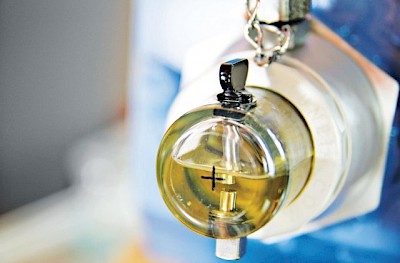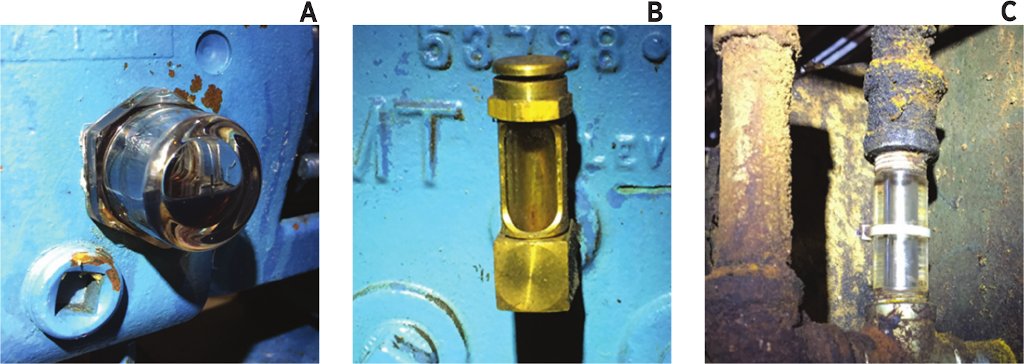The Most Important Lubrication Inspection Abnormal Changes in Oil Level
 A sudden change in oil level, either up or down, is a telegraphed alert that something is wrong. And, this “something” could potentially be serious. Deferring maintenance or ignoring this alert could lead to a costly repair and longer downtime in the future. The frequent examination of quality oil level sight glasses by trained inspectors is a sound condition monitoring practice. Perhaps the most important of all lubrication-related inspections.
A sudden change in oil level, either up or down, is a telegraphed alert that something is wrong. And, this “something” could potentially be serious. Deferring maintenance or ignoring this alert could lead to a costly repair and longer downtime in the future. The frequent examination of quality oil level sight glasses by trained inspectors is a sound condition monitoring practice. Perhaps the most important of all lubrication-related inspections.
Whether oil goes up or down, any sudden change in the oil level requires troubleshooting in search of the cause and corrective action. Just adding more oil or removing excessive oil is an activity of treating the symptom, not the cause. True, some oil level changes are rather common and quickly understood. For instance, if oil goes sharply down, you might have a conspicuous leak (internal or external) that can be easily found and plugged.
Internal leakage occurs when a fluid has gone from one compartment to another. Leakage may be associated with seal failure or perhaps the wrong oil in use. Low viscosity oils leak faster than high viscosity oils. An abrupt chemical change in a lubricant can affect its interfacial tension which can increase the rate of leakage.
If the oil level goes up, this may be due to the introduction of new fluid. For example, perhaps someone added too much oil, or another fluid like a coolant or even fuel has entered the system, which has raised the oil level.
What do Changes in Oil Level Mean?
Oil Too High:
When oil levels rise above the acceptable range usually something new has been added, i.e., a new fluid. But there are other options too.
Too much makeup fluid. Adding makeup fluid without carefully watching sight glasses can cause over-lubrication.
Oil drain back. If fluid is topped off while the machine is running, the oil level can climb when it stops and oil drains back from gears, bearings, oil galleries and distant zones or oil ways.
Aeration and foam. Such conditions can double or triple the apparent oil level.
Internal leakage. Various sources of internal leakage can cause other nearby fluids to invade the sump. These include coolant, washdown fluids, fuel, heat transfer fluid, hydraulic fluid, grease and process fluids. Oil analysis can identify these fluids.
Oil Too Low:
This is usually caused by leakage, but there are other reasons.
Out-leakage. This is an alert to examine the machine for any visual sign of oil leakage to external surfaces (oil exiting the machine).
Internal leakage. If no out-leakage is observed, are there other internal pathways and compartments where the oil might have gone? Look for rising fluid levels in these zones and compartments.
Gear climbing. Oil lifters, including paddle gears, slingers/flingers and the rotation of moving parts (gearing in particular) all draw oil out of sumps and reservoirs and lower the apparent oil level during machine operation.
Oil pump out. After startup, oil reservoirs can go down as the pump fills system lines and cavities such as gear cases, bearings, oil galleries and distant oil ways.
Bleed purge. Hydraulic and circulating systems often have bleed valves that when opened allow trapped pockets of air to purge and become replaced by oil. This draws the oil level down the reservoir.
Aeration and foam. Foam, in particular, lowers the liquid portion of level gauges, sometimes substantially. When the foam collapses (e.g., when the machine is at rest) the correct level should return unless foam was pushed out of vents and other headspace openings.
Excessive misting and volatilization. This is a form of out-leakage from various causes, such as the wrong oil (e.g., wrong viscosity), high temperature, excessive agitation, headspace vacuum, atomization/sprays or aeration.
Oil Too High or Too Low:
The following conditions can cause the oil level to appear to be too high or too low.
Air currents. Strong air currents moving across vents and headspace openings can alter the oil level in the gauges. When the air currents stop the oil level returns to normal.
Mechanical agitation. High-speed mechanical agitation, including rotation, can push oil towards or away from the level gauge ports.
Temperature. Hot oil and machine temperatures cause thermal expansion of lines, reservoirs and galleries. Extreme cold conditions do just the opposite.
Cylinder actuation. Both single-acting and double-acting hydraulic cylinders change the oil level in the tank up or down depending on the direction of actuation.
Reservoir pressure. Some reservoirs have positive headspace pressure (nitrogen or instrument air for instance) and others have negative pressure (extraction fans for instance). This can move the oil level slightly.
Sump or machine level. If the sump or the machine is off level, perhaps on a slope, this will affect the apparent oil level of the sight glass. This is common with mobile equipment.
Two Level Gauges are Better than One
It is a good practice to have an oil level gauge on both sides of some centrifugal pumps. If the pump is not centered in the casing, the oil level will not read correctly in the sight glass due to oil movement by the bearing. However, if you have two-level gauges, an average of the two readings will give a better-estimated oil level.
Q: Which of these sight glasses is better for detecting fluid level for oils that are colourless (clear and transparent)? Which is better for detecting aeration and foam?

A: The answer is A for both questions. Sight glass A can be viewed from any angle and produces a large top oil surface. It uses a port that is centerline with the oil level in the sump. This allows foam and rising air to be instantly observed. Sight glasses B & C use ports positioned well below the oil level. Sight glasses mounted below the oil level will not effectively trap rising air and foam for visual inspection. Additionally, such columnar sight glasses require adequate ventilation.
No comments:
Post a Comment